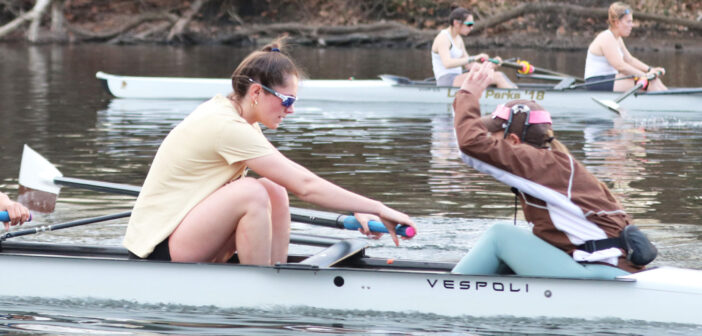Much of the leadership on a rowing team can be found in its smallest member — the coxswain.
While still considered a “rower,” a coxswain’s role contains no physical rowing. Instead, their job is to sit at the bow of the boat and instruct the team throughout the race. They face the opposite direction of their teammates and wear a headset that’s connected to speakers throughout the boat to steer.
Rowing coach Peter Costas knows this role is different than the but said it bears similarities to leadership positions in other sports.
“It’s a unique role in collegiate athletics that’s probably most similar to quarterback or point guard,” Costas said.
Senior Julia McDougall, has been a coxswain for the women’s rowing team since her first year. She said she understands the immense responsibility that comes with the position.
These responsibilities range from executing performance-based tasks to ensuring proper safety procedures are carried out during races.
“(I) ensure safety of the crew and boat by steering the course in the most competitive way,” McDougall said. “Another role is to execute the race plan and communicate that to the rowers.”
Boats are composed of four or eight people, excluding the coxswain. The coxswain’s sitting position helps them to see the path and direction.
Junior Ava Albano, another coxswain began her rowing career when she walked onto the team her first-year.
Being a coxswain means filling a leadership role, but being able to work with a productive team makes the role rewarding.
“I not only am in charge of putting the boat where it needs to be. I have the responsibility of helping my crew maintain rhythm, confidence and intensity throughout practices and races,” Albano said.
While it’s not an easy job, Albano said the coxswains are crucial to the function of a boat and the entire team.
She said a coxswain must have a blend of communicative, inclusive and authoritative leadership, as the role involves communicating with teammates, coaches, marshalls and other crews throughout a race.
“It is important we form meaningful connections and trust with our teammates, learning how each one of them responds to calls and what motivates them,” Albano said. “We also are mini coaches in a way, so forming a sense of trust and respect with our rowers is key.”
McDougall said coxswains must be natural leaders that take feedback from rowers and find solutions that are best for the boat.
She also said it’s important for her to balance multiple tasks at once to ensure the boat is being steered in a straight line while simultaneously calling the race and providing feedback.
The coxswain is the only individual who can talk during races, and Albano said it’s her job to anticipate what her teammates need and how she can help, as well as making quick decisions on the fly.
She also said the role is much more mental than physical, and it’s important she keeps morale high during races in order to maintain the boat’s focus.
The coxswain’s influence extends beyond their seat in the boat.
McDougall said strong communication with teammates out of the water is the best way for her to gain their trust in the water.
Costas said he’s appreciative of the consistency and effort that each coxswain exhibits for the team’s performances and culture. Their hard work in turn creates positive results.
“They communicate effectively between one another to make for effective team practice sessions, and we’re a more productive program for that trust and efficacy,” Costas said. “(I’m) grateful to have the high bar set in years past continue to impact the culture of our program.”






Comment policy
Comments posted to The Brown and White website are reviewed by a moderator before being approved. Incendiary speech or harassing language, including comments targeted at individuals, may be deemed unacceptable and not published. Spam and other soliciting will also be declined.
The Brown and White also reserves the right to not publish entirely anonymous comments.